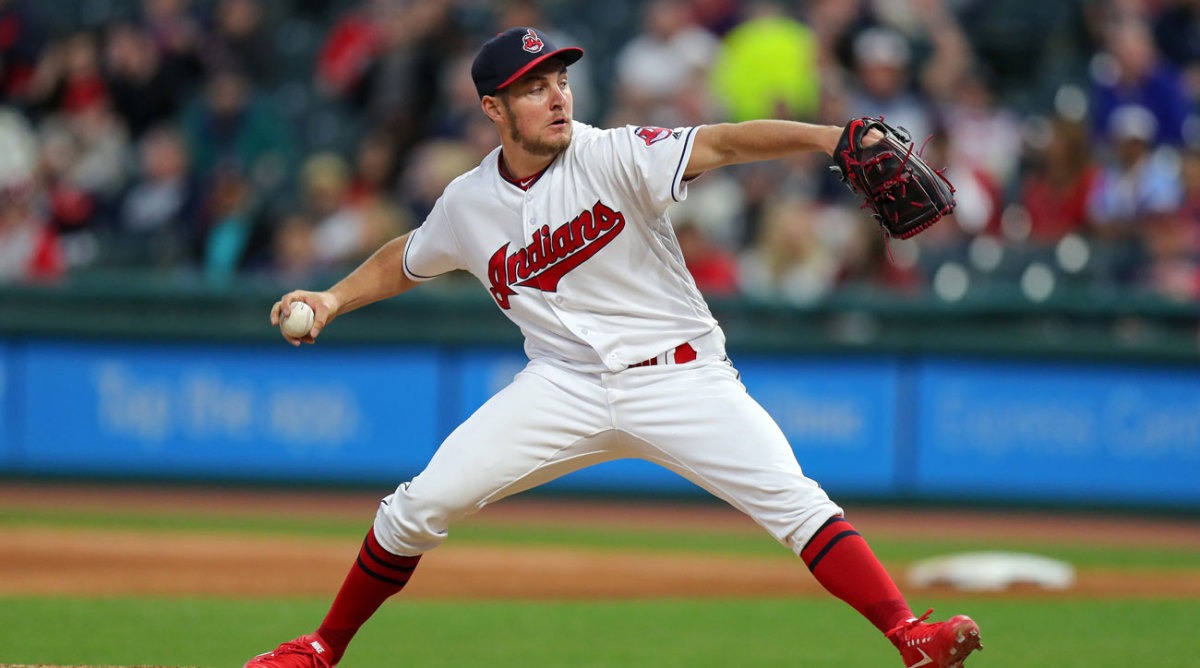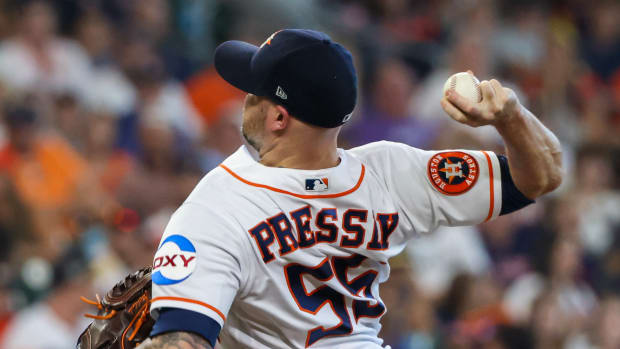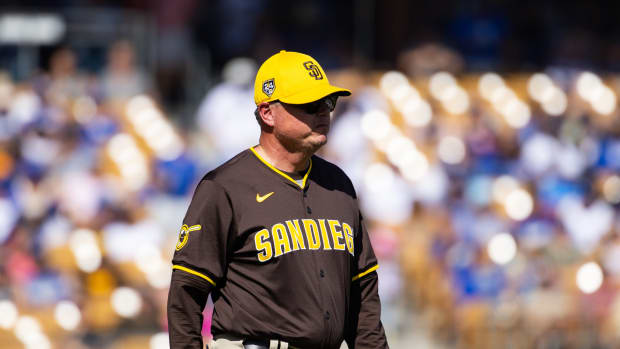Trevor Bauer's Veiled Accusations of the Astros May Have Merit ... But They're Probably Personal

HOUSTON — A few offseasons ago I was in a Quonset hut in Montgomery, Texas, talking to Trevor Bauer about how a pitched baseball spins. As he had done since he was an adolescent, the Cleveland Indians pitcher was training at the Texas Baseball Ranch, a state-of-the-art training facility to improve throwing mechanics, velocity and arm health.
Bauer might know more about how a baseball spins than any person in uniform today. Such a student of spin is Bauer that he bought himself a Trackman system and high speed cameras to create his own pitching lab at home. In that lab Bauer was able to as closely as possible duplicate the two-seam fastball of Corey Kluber, in terms of how it came out of his hand and the axis on which it spun. It’s the baseball version of cloning, or 3D printing. You can make copies if you know the DNA of a pitch’s spin—and have a baseline of major league talent.
So I asked Bauer, “If people now are learning how to throw harder, how can they learn to spin a four-seam fastball faster to create the ‘life’ everybody wants on their heater?”
Bauer essentially told me it couldn’t be done. He explained that when you backspin the ball with your hand directly behind the ball—not to the side, or not with any degree of side spin—there’s nothing you can do about making it spin appreciably faster. Your spin rate on your best fastball is like your fingerprint—it is what it is.
Pitching labs have since figured out there is a way to improve the spin rate: load up pine tar or a similar sticky substance on your fingers. With more tackiness, you can create more spin. It’s not exactly legal. Applying a bit of pine tar to your fingers is an accepted practice—enough so that the baseball is not slick—but applying too much or too conspicuously is verboten.
Now you have some background on where Bauer came from when he tweeted his curiosity about how a pitcher could “bump his spin rate a couple hundred rpm overnight … imagine the steals you could get on the trade market!”
The tweet was in response to another tweet about spikes in the Astros’ spin rates, and whether pine tar or a similar substance might be a cause.
Bauer did not directly charge Houston with foul play, but said his “gripe” was with MLB’s “hypocrisy” when it comes to its rules regarding foreign substances. (Every night in just about every game you will see a pitcher reach after every pitch across the skin of the forearm of his non-throwing arm, where is found a ready supply of sunblock or some homemade concoction to better grip the baseball. Some pitchers put their stash on their neck—front or back—some on the bill of their caps and some even in their beard.)
So was Bauer on to something? Should the Astros be upset? To answer those questions, here’s a “no-spin zone” on the whole spin debate. I’ll give you nothing but the facts. Then you can put your own spin on the issue:
Fact 1: Justin Verlander’s four-seam spin rate essentially did not change after he was traded to Houston last year.
Here is Verlander’s four-seam spin rate last year with Detroit: 2,538 rpm.
Here is Verlander’s four-seam spin rate last year after his trade to Houston, including the postseason: 2,569 rpm.
Statistically insignificant.
Now here is what I can tell you about Verlander’s spin rate: it cratered in 2014 and 2015 because of core muscle surgery.
“I hurt the whole year,” Verlander said about 2014, “and into the next season. It took a long time before I felt right and my mechanics were right.”
Verlander said he can look at a picture of himself throwing and can tell instantly in what year it was taken. So I took him up on the offer and showed him two pictures, one from 2014 and one from 2017—both shot from the same angle (third-base side) and at the same moment (after his front foot just landed). Verlander immediately knew the difference.
Because of the core muscle surgery, Verlander fell into a mechanical flaw of what is called “forearm flyout.” It describes the position of the forearm as the front foot lands. Ideally, the ball should be in the fully loaded position with the upper arm and forearm forming about a 90-degree angle—or even better, as Greg Maddux, Bartolo Colón and Kyle Hendricks mastered—even less of an angle, which takes greater strain off the shoulder.
The greater the angle, the greater the strain. Don’t believe me? Try this experiment. Take a three-pound weight and hold it away from your head with your arm bent at more than 90 degrees. It doesn’t take long until your shoulder and arm begin to fatigue. Now hold the same weight closer your head with your arm creating an angle of less than 90 degrees. You can hold it there all day.
In 2014 and 2015 when Verlander’s foot landed the ball was farther from his head than it should have been and the angle created by the bend in his arm was far greater than 90 degrees— thus the term “forearm flyout.” It creates timing problems in the delivery, which saps “life” on pitches. It’s the same flaw that dogs Matt Harvey of the Mets, and has caused him to lose spin off his four-seam fastball—spin he’s not getting back unless he addresses his mechanics.
After the 2015 season Verlander sought a private coach to remedy the flaw. He learned corrective drills using inflatable balls called “connection balls.” You try to hold one of the balls in place on top of your throwing shoulder while forming the ideal loaded position. Only when your arm gets to the proper 90-degrees or less angle can you keep the ball wedged on your shoulder between your arm and your head.
It’s boring work, but it’s necessary to re-train your movements.
By getting his delivery “connected” again—the lower half, upper half and arm all in synch—Verlander re-discovered the life on his fastball. Want proof? Here you go, entering his 14-strikeout start Tuesday night against the Yankees:
Verlander Four-Seam Fastball Metrics
Year | MPH | Spin Rate | Avg. | SLG% |
2015 | 93.4 | 2,491 | .232 | .395 |
2016 | 93.6 | 2,556 | .238 | .477 |
2017 | 95.3 | 2,541 | .207 | .312 |
2018 | 94.6 | 2,629* | .153 | .264 |
* Highest among all starting pitchers
So, yes, Verlander’s four-seam spin rate has gone up by 135 rpms since 2015 (not since the trade)—but that’s because of health, training and mechanics. He told me he now uses the connection balls only occasionally, as when he feels like he needs a quick tuneup. I mentioned that it sounds like using alignment rods on the golf driving range once in a while. “Exactly like that,” he said.
Fact 2: Verlander, at 35 years and 71 days, on Tuesday night became the fourth oldest pitcher ever to strike out 14 or more batters while not allowing a run or a walk.
The only older such masters: Roger Clemens for the 1998 Blue Jays (36.021), Randy Johnson for the 2004 Diamondbacks (40.319) and Nolan Ryan for the 1990 Rangers (43.198).
He’s only the fourth pitcher—of any age—to pitch that well and get a no decision, joining Chris Sale (2015), Johnson (2004), Ryan (1990) and Vida Blue (1971).
Fact 3: Charlie Morton doesn’t use pine tar.
“Never have,” he said.
Something for a better grip?
“Nope. Nothing. Just saliva to wet my fingers when they’re dry.”
(Perfectly legal.)
What has changed is almost everything else about Morton. He lost weight (down from a high of 240 to about 210), which allows his body to generate more speed; he adopted a rigorous training program in 2015 in Bradenton, Fla., and has stuck to it (“It took a while to get through a workout without heaving,” he said); he morphed from a sinkerball pitcher with poor mechanics who tried to pitch to contact to a fast-moving dynamo who throws four-seamers as hard as he possibly can (“I’m a thrower now,” he said, “and I feel it more the next day.”)
Fact 4: Dallas Kuechel relies on a sinker, which means deadening the ball.
“I don’t want spin,” he said.
Fact 5: The Astros’ pitching coach, Brent Strom, has known Bauer since the pitcher was a young boy learning about pitching and analytics at the Texas Pitching Ranch, where Strom has been a consultant.
“His dad’s an engineer,” Strom said, laughing. “I called him and said, ‘You should give Trevor a good spanking.’ I’ve known Trevor forever.”
Fact 6: Gerrit Cole’s four-seam spin rate has jumped this year after his trade from Pittsburgh to Houston.
Okay, now we get to what looks like the real beef of Bauer. Cole and Bauer were teammates at UCLA. In 2011 Cole was drafted first overall by Pittsburgh and Bauer was drafted third by Arizona. In November of 2012 Tom Singer, writing for MLB.com, wrote that Cole and Bauer were “developing a dislike for each other” that “became so bitter” that each refused to comment on the other.
Take a look at what has happened to Cole’s four-seam spin rate:
Gerrit Cole Four-Seam Spin Rate
YeAR | SPIN RATE |
2015 | 2,157 |
2016 | 2,183 |
2017 | 2,163 |
2018 | 2,332 |
Batters never hit worse than .243 against Cole’s four-seam fastball—until this year. They’re hitting .110. Okay, small sample—it’s just one month.
But that jump in four-seam spin rate (albeit based on 274 heaters this year and 1,603 last year) is eye-catching. I don’t know of an equivalent. We’ll have to see how the year plays out.
Now look at Bauer’s fastball:
Trevor Bauer Four-Seam Spin Rate
YeAR | SPIN RATE |
2015 | 2,294 |
2016 | 2,276 |
2017 | 2,240 |
2018 | 2,230 |
That’s the kind of consistency you would expect to see from a healthy pitcher. It’s also almost the exact definition of an average four-seam fastball. This year the MLB average is 2,262.
So here you have Bauer—the ultimate spin nerd, with his own Trackman system, his devotion to understanding the physics and biomechanics of pitching—and no matter what he does he is stuck with average spin on his heater.
And now here is Cole, his college teammate and apparent rival, who never spun the ball as fast he does, and suddenly he is zooming past Bauer in four-seam spin rate. Apparently from such discoveries are Twitter wars born.




































